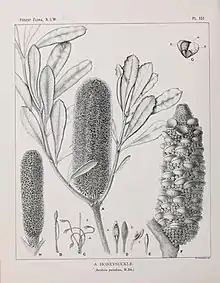Margaret Flockton
Margaret Lilian Flockton (29 September 1861 Sussex – 12 August 1953 Sydney), was an Australian botanical artist, particularly noted for her illustrating of "The Forest Flora of New South Wales" (some 300 plates), "A Critical Revision of the Genus Eucalyptus" (88 plates), and the genus Opuntia, all by the botanist and forester, Joseph Henry Maiden. She was the first botanical illustrator at the Royal Botanic Gardens in Sydney.[1]
Margaret Flockton | |
|---|---|
 | |
| Born | 29 September 1861 Sussex |
| Died | 12 August 1953 (aged 91) Sydney |
| Nationality | Australian |
| Education | South Kensington Schools |
| Known for | Botanical art |
Notable work | The Forest Flora of New South Wales |

Plate 33 from Forest Flora of New South Wales
Training and teaching
Her early studies were at the South Kensington Schools in London, where, unusually, she was trained in lithography, and also Miss Gann's Life School. She emigrated to Australia in 1881, accompanied by her sister, Mrs Boulton, and were later joined by their parents, Francis and Isabel. Her first regular employment extending over 7 years, was as commercial artist for the Sydney firms of Gibbs, Shallard & Co. and S.T. Leigh. Since her father Francis was also an artist, it is not surprising that she dedicated her life to art and never married.
To teach art, she opened a studio in Victoria Chambers, Castlereagh Street in Sydney, while her home was at "Tulagi", 30 Kemp St. in Tennyson Point, a suburb of Sydney, where she died shortly before turning 92. Her work was exhibited with the Royal Art Society between 1894 and 1901, consisting of wildflower studies and still-life paintings. In 1895 her watercolour of waratahs was purchased by the Art Gallery of New South Wales.
Royal Botanic Gardens, Sydney

She started work at the National Herbarium of the Royal Botanic Gardens, Sydney on 3 June 1901 at the rate of "2 shillings per hour" and was earning £330 per annum at her retirement in 1927.[2] For 27 years, from age 40 to 67, she turned out botanical drawings of the highest quality, making use of a camera lucida. There are some 1000 of her illustrations in The Botanic Gardens Trust Archive.[3]
At that time Maiden was Director of the Botanic Gardens and Government Botanist, and was greatly impressed by the standard of her work, considering her "the most accomplished botanical artist in New South Wales", and inviting her to produce the illustrations for "A Critical Revision of the Genus Eucalyptus", which he was writing. Consequently, she spent 12½ hours a week at the Botanic Gardens and 25 hours at the Forestry Department. In the end Flockton stayed on at the Botanic Gardens for five years beyond her retirement age, her last day of work at the Gardens being on 24 March 1927. In recognition of her contributions to botanical art, and referring to her as joint author of his works, Maiden named a few species after her - Eucalyptus flocktoniae, Acacia flocktoniae and the Dorrigo Daisy-bush Olearia flocktoniae.[4][5]
The lion's share of Flockton's work consisted of botanical illustration and she produced the necessary lithographs herself, being at that time the only female lithographer in Australia. She published various books on her own, such as a small volume "Lichens", "Australian Wildflowers" (1908), illustrated with her coloured lithographs, and produced the wildflower borders for butterfly studies in "Scenic Gems of Australia", by Dr Riches. Much later in life she wrote and illustrated "Children's Stories - Little Stories of Little People", describing the life-history of plants and insects, but which remained unpublished. One of the students in her oil and watercolour classes, was Mary Maiden, daughter of Joseph Henry Maiden. Mary later worked at the Botanic Gardens as an illustrator in a voluntary capacity.
After her retirement the vacant post was not filled until the early 1980s, when the "Flora of New South Wales" was launched, employing 19 illustrators, 16 of whom were women.
Legacy
The Margaret Flockton Art Award, now the Margaret Flockton Award, was created in 2004 in her memory,[6] and two prizes of A$5000 and A$2000 are awarded annually for excellence in botanical illustration.[7][8]
Flockton Place in the Canberra suburb of Chisholm is named in her honour.[9]
References
- Hawley, Janet (9 April 2016). "Rare at discovery". The Sydney Morning Herald. Archived from the original on 20 August 2020.
- "Margaret Flockton". Council of Heads of Australasian Herbaria - Biographical Notes. Retrieved 8 April 2017.
- Payne, Christine (1996). "Margaret Flockton". Australian Garden History. 8 (3): 13.
- Olearia flocktoniae PlantNet
- Acacia flocktoniae PlantNet
- Elkan, Lesley; Wardrop, Catherine. "Margaret Flockton at the Royal Botanic Gardens, Sydney". Archived from the original on 29 May 2019. Retrieved 20 August 2020.
- Margaret Flockton Botanical Art Award
- "The Margaret Flockton Award". Archived from the original on 29 October 2020. Retrieved 17 December 2020.
- "Schedule 'B' National Memorials Ordinance 1928-1972 Street Nomenclature List of Additional Names with Reference to Origin: Commonwealth of Australia Gazette. Special (National : 1977 - 2012) - 8 Feb 1978". Trove. p. 11. Retrieved 2 April 2020.
External links
- Margaret Flockton Art Award 2016-2018 (Flickr)
- Lesley Elkan and Catherine Wardrop (2014). "Margaret Flockton at the Royal Botanic Gardens, Sydney". Dictionary of Sydney. Dictionary of Sydney Trust. Retrieved 13 October 2015.
- Wilson, Louise; Flockton, Margaret, 1861-1953, (artist.) (2016), Margaret Flockton : a fragrant memory, Wakefield Press, ISBN 978-1-74305-447-5CS1 maint: multiple names: authors list (link)
- A Critical Revision of the Genus Eucalyptus, 8 volumes BHL.